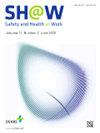Occupational Hazards in Lead-acid Battery Factories in Bangladesh: Assessing Excess Heat, Noise, Chemical Exposures, and Health Impacts on Workers
IF 2.9
3区 医学
Q1 PUBLIC, ENVIRONMENTAL & OCCUPATIONAL HEALTH
引用次数: 0
Abstract
Background
Lead-acid battery (LAB) manufacturing is growing in Bangladesh because of the expanding automotive industry and low lead prices. Although these factories employ a big workforce, the working environment has led to concerns about the possible health risks for employees. This study aimed to address this issue by investigating workplace chemical and physical hazards in three LAB industries and evaluating health outcomes among workers.
Methods
A cross-sectional study was conducted among 72 LAB factory workers, and participants were recruited by simple random sampling. A validated questionnaire was used to collect information on self-reported exposures to physical and chemical risks and related health effects. Data analysis was performed by using statistical software SPSS version 25.
Results
The age and work experience (Mean ± SD) of the participants were 34.2 ± 7.7 and 10.0 ± 5.7 years, respectively. High workplace temperature and noise from machinery, chemical odors, and skin exposure to acid (H2SO4) were reported by 52.8%, 51.4%, and 20.8% of workers, respectively. Insomnia (25.0%), abdominal pain (18.1%), joint pain (38.9%), memory loss (19.4%), headache (15.3%), low back pain (47.2%), eyesight problem (19.4%), physical weakness (47.2%), and hypertension (19.4%) were all common symptoms among the workers.
Conclusion
Our study findings indicate that workers in LAB factories in Bangladesh are exposed to extreme temperatures, hazardous materials, and uncomfortable levels of noise, which can lead to serious health risks. To ensure the safety and well-being of employees, the LAB manufacturing sector in Bangladesh requires the immediate implementation of proper occupational health and safety standards.
孟加拉国铅酸蓄电池工厂的职业危害:评估过热、噪音、化学品接触和对工人健康的影响
背景:由于不断扩大的汽车工业和较低的铅价,孟加拉国的铅酸电池(LAB)制造业正在增长。尽管这些工厂雇佣了大量的劳动力,但工作环境已经引起了人们对员工可能面临的健康风险的担忧。本研究旨在通过调查三个LAB行业的工作场所化学和物理危害并评估工人的健康结果来解决这一问题。方法采用简单随机抽样的方法,对72名LAB工厂工人进行横断面调查。使用一份有效的问卷收集关于自我报告的物理和化学风险暴露及其相关健康影响的信息。采用SPSS 25版统计软件进行数据分析。结果被试的年龄和工作经验(Mean±SD)分别为34.2±7.7岁和10.0±5.7岁。52.8%、51.4%和20.8%的工人分别报告了工作场所的高温和机械噪音、化学气味和皮肤暴露于酸(H2SO4)。失眠(25.0%)、腹痛(18.1%)、关节痛(38.9%)、记忆力减退(19.4%)、头痛(15.3%)、腰痛(47.2%)、视力问题(19.4%)、身体虚弱(47.2%)和高血压(19.4%)是工人的常见症状。我们的研究结果表明,孟加拉国实验室工厂的工人暴露在极端温度、有害物质和令人不舒服的噪音中,这可能导致严重的健康风险。为确保雇员的安全和福祉,孟加拉国劳顾会制造部门要求立即执行适当的职业健康和安全标准。
本文章由计算机程序翻译,如有差异,请以英文原文为准。
求助全文
约1分钟内获得全文
求助全文
来源期刊

Safety and Health at Work
Social Sciences-Safety Research
CiteScore
6.40
自引率
5.70%
发文量
1080
审稿时长
38 days
期刊介绍:
Safety and Health at Work (SH@W) is an international, peer-reviewed, interdisciplinary journal published quarterly in English beginning in 2010. The journal is aimed at providing grounds for the exchange of ideas and data developed through research experience in the broad field of occupational health and safety. Articles may deal with scientific research to improve workers'' health and safety by eliminating occupational accidents and diseases, pursuing a better working life, and creating a safe and comfortable working environment. The journal focuses primarily on original articles across the whole scope of occupational health and safety, but also welcomes up-to-date review papers and short communications and commentaries on urgent issues and case studies on unique epidemiological survey, methods of accident investigation, and analysis. High priority will be given to articles on occupational epidemiology, medicine, hygiene, toxicology, nursing and health services, work safety, ergonomics, work organization, engineering of safety (mechanical, electrical, chemical, and construction), safety management and policy, and studies related to economic evaluation and its social policy and organizational aspects. Its abbreviated title is Saf Health Work.
 求助内容:
求助内容: 应助结果提醒方式:
应助结果提醒方式:


